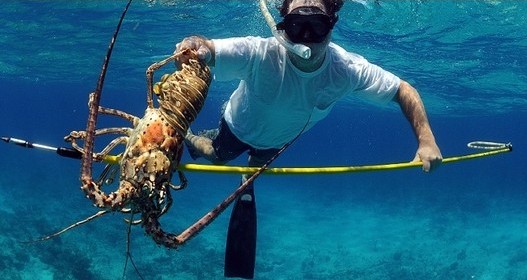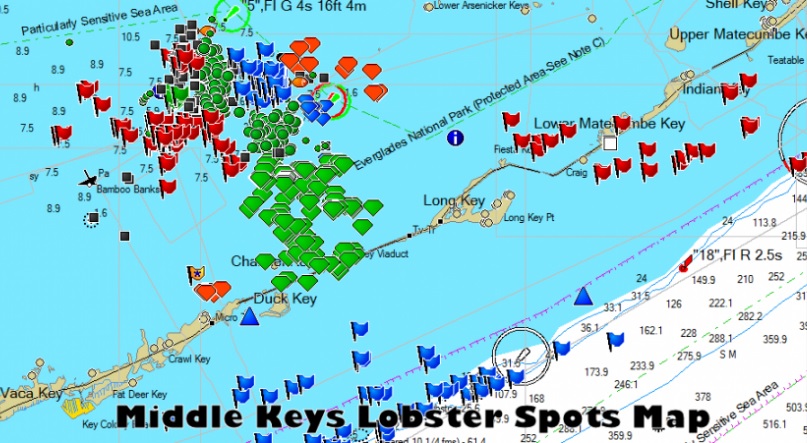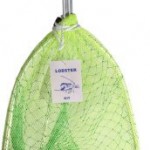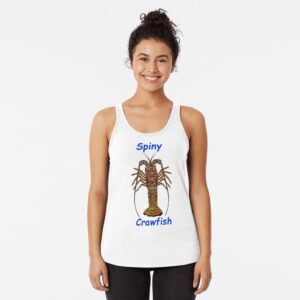The main difference between the Florida Keys Spiny Lobster and the American or Maine Lobster are the front claws. American / Maine lobsters have large front claws. Florida Keys Spiny Lobsters do not. Clawed lobsters are known as cold water lobsters, while Florida lobsters are known as warm water lobsters. Florida lobsters are caught for their tail meat, while Maine lobster is known for its claw and tail meat. Young larvae and juvenile Florida lobsters stay in shallow waters to hide from predators. One of their most common predators is the Lionfish, a foreign, invasive species which was unnaturally introduced to the Atlantic Ocean, most likely from aquarium owners dumping them in the sea. A Lionfish can consume 20 baby lobsters in just 30 minutes.
 As Florida lobsters grow, their predators grow along with them, to eels and sharks. In the fall and winter, as waters cool, Florida Spiny Lobsters go to deeper waters. As the shallow waters warm in summer months, Lobsters return to more shallow areas. Florida lobsters are said to be descendants of the Caribbean lobster, due to large water circulation patterns and weather patterns transporting the lobster larvae long distances.
As Florida lobsters grow, their predators grow along with them, to eels and sharks. In the fall and winter, as waters cool, Florida Spiny Lobsters go to deeper waters. As the shallow waters warm in summer months, Lobsters return to more shallow areas. Florida lobsters are said to be descendants of the Caribbean lobster, due to large water circulation patterns and weather patterns transporting the lobster larvae long distances.
Spiny lobsters generally eat at night. They eat smaller crustaceans, mollusks, chiton, and bivalves. They take on the color of their food, either red or green, depending on the color of the algae that covers their prey.
Where to Find Florida Keys Spiny Lobster

When hunting Florida Keys Spiny Lobster in Florida, look no further than the Florida Keys. The best lobster spots are located on the Gulf (Bay) side of the Middle Keys just north of Marathon, south of Long Key and the 7 Mile Bridge. This is due to the abundant natural Lobster Habitat found in the area including: Duck Key, Long Key, Conch Key, Lower Matecumbe Key. The rocks surrounding the bridges of Duck Key are an especially popular spot for catching lobster. There may be 10 other groups there, but there will be more than enough lobster to go around.
A great tip according to FloridaLobstering.com is to find a rocky bottom in 5 – 15 feet water, and troll around with two ski ropes pulling two guys behind the boat. If someone finds a lobster, drop off the rope, and have the boat circle back. Then mark the spot with the GPS and come back at a later time, or go right ahead and go for the catch. Lobsters like to hide under rocks and coral, and you can often spot their antennas sticking out. Even if you don’t see the antennas, and it looks like a particularly nice hiding spot (you just get that gut feeling), go a bit lower and investigate, you may just find a little hidden lobster lair. And if you find a great spot, that is not yet known by others… keep it to yourself and return year after year!
How to Catch Caribbean and Florida Keys Spiny Lobster
Essential gear for when lobstering down in Florida: Tickle sticks, Lobster nets or snares, Measuring gauge, Lobster gloves (especially important because of lobster’s spiny shells), Lobster bags (make sure you keep them contained once you catch ’em!), Diving hookah, scuba gear (or big lung capacity!), Underwater fishing lights (for lobstering at night).
First and foremost, it’s important to know how Spiny Lobsters behave and move = Florida Spiny Lobsters will move forward very slowly and cautiously. However, if frightened they will use their tail to shoot backward very rapidly. If hunting with a net, you will want to take advantage of this natural reaction. When hunting with a net, use a “tickle stick” to gently tap the lobster on the tail. This will cause it to walk forward. If not, you can be a bit more aggressive and use a sweeping motion to try and force it out of its hole. Once out of the hole, the best option is to try and trap the lobster between the net and the ground, starting with the net behind the lobster in case he jets backward. If not possible, place the net behind the lobster, and simply tap it on its forehead. This will freak him out, and cause him to shoot backward right into your net. Then QUICKLY swoop the end of the net around the lobster to trap it.
Another option is to catch the lobster with a snare, a much quicker and more direct method.
Now that you are a certified, diving lobster hunter, you can’t just go in and snatch up as many lobsters as you’d like… there are limits to this thing.
- A lobster must have a carapace (it’s “torso” or body if you will) of at least 3 inches. This means it would be at least 2 or 3 years old and have lived long enough to have reproduced at least one season. You must place the measuring gauge starting at its head, between the eyes, and making sure the end of its carapace is longer than the 3 inch marker.
- The lobster must be measured in the water, if harvested while hookah diving or diving in general.
- You can only catch 6 lobster a day.
- Each person fishing for Florida Keys Spiny Lobster will need a saltwater fishing license and a spiny lobster tag.
Source: Your Guide To Florida Lobstering & Hookah Diving!

The Perfect kit for Florida Lobster. Here are all the vital things you need when you dive for the
“bugs”. Start with a durable, aluminum tickle stick for backing your catch into the quality strength aluminum framed net. The honeycombed gloves allow you to easily grip the bug. The aluminum lobster gauge (you are required to have on in your possession when lobstering) is easy to measure your catches to make sure they are not under the legal size limit. And finally, a large mesh bag to store your catch.
Click Here to get your kit delivered to you in time for your Lobster Hunt!

